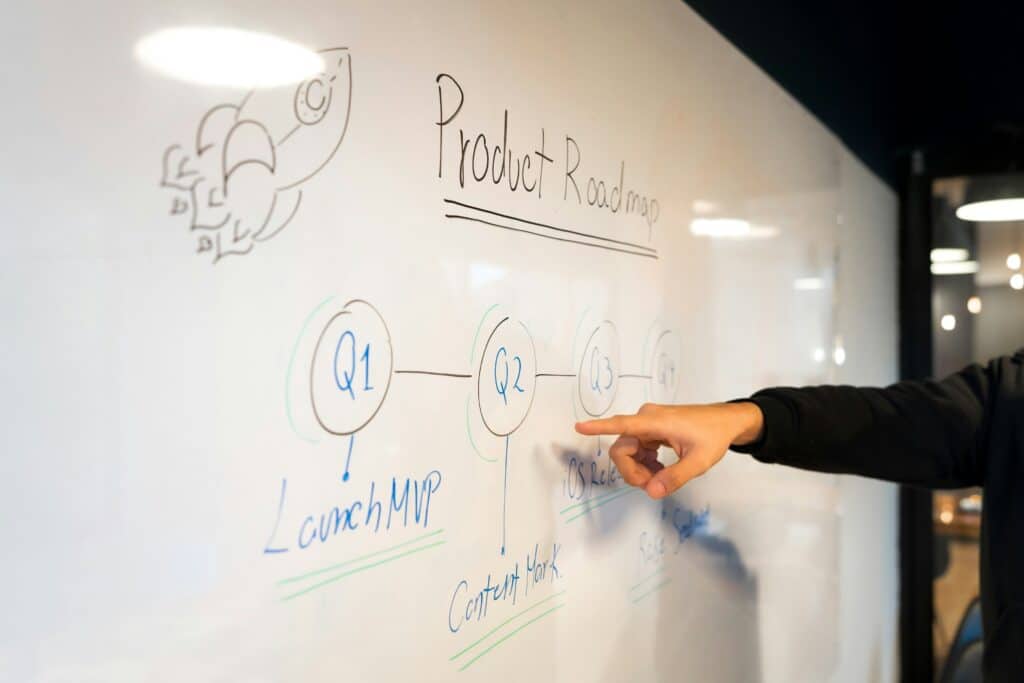In today’s fast-paced, competitive world of software development, building a product roadmap is about more than just listing features or setting release dates—it’s about strategy. At OpenArc, we believe that truly impactful roadmaps are rooted in a deep understanding of market dynamics and customer needs. One powerful framework that can help guide this process is Porter’s Five Forces.
Developed by famed strategist Michael Porter, the Five Forces framework analyzes the competitive forces shaping an industry. At OpenArc, we understand that creating a successful software product isn’t just about writing code – it’s about making strategic decisions that drive long-term success. How do you ensure your product roadmap addresses not just features, but market dynamics?
1. Industry Rivalry: Stand Out by Benchmarking and Differentiating
The software market is fiercely competitive, and understanding where your product stands against competitors is essential. Regular benchmarking of features, pricing, and user experience is the first step to ensuring your product doesn’t get left behind.
At OpenArc, we encourage our clients to:
- Analyze Competitors’ Strengths and Weaknesses: Identify gaps in the market or areas where your product can excel.
- Prioritize Differentiation: If competitors are focused on usability, for example, consider investing in advanced functionality, unique integrations, or innovative technology that sets your product apart.
- Refine Your Value Proposition: Use competitive insights to shape roadmap initiatives that emphasize what makes your product unique and valuable to users.
Did you know that 68% of software products fail due to poor market differentiation? That’s why we help our clients build roadmaps that emphasize unique value propositions.
2. Threat of New Entrants: Build Defensibility and Reduce Friction
New players are always looking to enter the software space, and reducing their ability to disrupt your market is key to long-term success. The roadmap can play a critical role in building barriers to entry.
Here’s how OpenArc approaches this challenge:
- Minimize Onboarding Friction: Make it easy for customers to adopt and use your product. Prioritize usability improvements and seamless onboarding experiences to increase customer retention.
- Create Defensibility: Invest in features that are difficult for new entrants to replicate, such as network effects (e.g., community features or integrations that create value as more users join) or proprietary technology.
- Move Quickly: Speed matters when countering new entrants. Agile roadmapping allows you to rapidly release new features and maintain your competitive edge.
By focusing on defensibility and ease of use, you can make it harder for new players to lure your customers away.
3. Bargaining Power of Suppliers: Reduce Dependency
If your product relies on expensive third-party suppliers—such as cloud providers, APIs, or proprietary technology—it’s important to consider how supplier dynamics can impact your roadmap.
At OpenArc, we help clients:
- Reduce Dependency: Explore roadmap initiatives that allow you to build in-house solutions or leverage open-source alternatives. This not only reduces costs but also gives you greater control over your product.
- Diversify Suppliers: If going in-house isn’t feasible, consider diversifying your dependencies by integrating with multiple suppliers to minimize risks.
- Strengthen Partnerships: Use your roadmap to prioritize features or integrations that align with key supplier relationships, fostering mutual benefit.
A proactive approach to supplier management ensures that external factors don’t jeopardize your product’s success.
4. Bargaining Power of Buyers: Deliver Tangible Value
Your customers hold significant power, especially in markets where switching costs are low. To retain them and reduce churn, your roadmap needs to focus on delivering real, tangible value.
OpenArc’s approach includes:
- Addressing Customer Pain Points: Use customer feedback and usage data to identify the biggest problems they face and prioritize features that solve them.
- Driving Loyalty: Add features that enhance customer satisfaction and loyalty—whether through better integrations, performance improvements, or tailored solutions.
- Justifying Pricing: Build value-driven features that make customers feel they’re getting more than they’re paying for. This reduces price sensitivity and creates advocates for your product.
By putting the customer at the center of your roadmap strategy, you can build stronger relationships and long-term loyalty.
5. Threat of Substitutes: Innovate Continuously
Substitute products—often from adjacent markets—can be a silent threat. To stay ahead of substitutes, continuous innovation should be a cornerstone of your roadmap.
OpenArc advises clients to:
- Invest in Unique Features: Focus on innovations that substitutes cannot easily replicate. This could mean investing in proprietary technology or features tailored to specific niches.
- Broaden Use Cases: Expand the problems your product solves by adding complementary features or capabilities. This makes it harder for substitutes with limited scope to compete.
- Enhance User Experience: A superior user experience (e.g., reliability, speed, ease of use) can often be the deciding factor when customers weigh substitutes.
By continuously innovating and expanding your product’s value proposition, you can safeguard against substitutes and maintain a competitive edge.
The OpenArc Advantage
We’ve helped numerous clients transform their product roadmaps from simple feature lists into strategic weapons. Our process combines deep technical expertise with market-driven insights to create sustainable competitive advantages.
Want to see how we can help strengthen your product strategy? Contact us today to schedule a strategic roadmapping session. Our team of experts will help you:
- Analyze your competitive position
- Identify strategic opportunities
- Create an actionable roadmap for success
Visit OpenArc.com/contact or call us at 724-602-0286 to get started.
Remember: A great product strategy isn’t just about what you build – it’s about why you build it. Let us help you make those decisions count.
